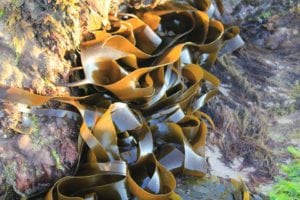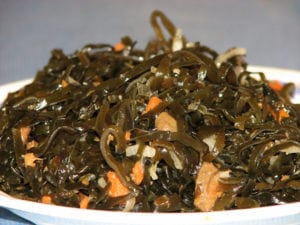
Image credit: bluebudgie
Any seafood, if they are quality and properly cooked, are good for your health. A special place among them is occupied by kelp, with respect to all other seafood, they are affordable for almost everyone. At the same time, their health benefits are great – they are rich in vitamins, contain a lot of easily digested iodine, but at the expense of a specific taste like not everyone likes. However, there are ways to diversify your diet by adding Laminaria to it to help prevent many diseases, while breaking its specific taste or disguising it.
Seafood of a special kind – kelp
When the term seafood is used, it is understood for the most part by various seashells, shrimps and other delicacies, although edible algae can also be attributed to this group. The most famous and common in our country are laminaria or as they are called in another way – sea kale. These seafood are not only used for food, but are also actively used today in cosmetology. These algae grow in many seas, they are collected from the seabed by special devices on which the leaves are wound, reaching the length of up to 30 feet.
This type of seafood is known for a long time, the inhabitants of coastal countries used them for food many centuries ago, in many countries it was used not only as a food product, but also as a cure for many diseases. It is believed that if the Laminaria has sharply wanted, the body suggests that he lacks many vitamins, and he suffers from a shortage of iodine.
Benefits of kelp: vitamins
These algae are a valuable vitamin product, they find almost all the vitamins necessary for the body – group B, as well as fat-soluble compounds. In addition to the fact that the kelp contains the necessary vitamins, they are also a concentrate of mineral compounds – sodium, chlorides, calcium and potassium, magnesium. Due to its structure and composition, laminaria refers to dietary and curative-preventive foods. Algae in its pure form – for 100 grams of the product have a caloric value of about 25 kcal, with the addition of oil and spices, greenery caloric content can rise to 50 kcal. Add here a full range of vitamins and minerals needed for people striving for harmony – the product is very useful for losing weight.
Iodine and not only …
Naturally, due to the high content of iodine in sea kale, it is most useful for those who suffer from a deficiency of this trace element. Therefore, in regions where iodine in food and water is in short supply, at least once or twice a week it is necessary to include this product in the diet. But not only due to the high content of iodine, this alga is valued, it has a beneficial effect on health and helps in the prevention of many diseases.
The product contains a large number of unsaturated fatty acids, which help to fight excessive thrombus formation in the walls of the vessels and are the prevention of atherosclerosis. Enhance the effects of these compounds high concentrations of ascorbic acid (vitamin C), the content of which kelp overtake citrus fruits. No less useful is sea kale in the treatment of blood diseases – it has a lot of iron, useful in anemia.
Amino acids, which are contained in the plant, help to replenish stocks to those people who, for various reasons, do not consume meat. It is no less useful in old age, when cardiovascular diseases manifest themselves, metabolism slows down and nutrient deficiencies appear.
At what illnesses it is possible and it is impossible
In addition, the use of Laminaria helps in the fight against atherosclerosis due to the content of its sterol, a compound that can reduce the formation of cholesterol plaques on the walls of blood vessels. Also positive influence of its reception on reproductive functions of both women and men is proved.
Alginates in the plant help in stimulating immunity, have antitoxic and antitumor effect, in addition, the ability of algae to swell in the treatment of digestive diseases, especially constipation. Ancient Chinese medicine used these algae when recovering from a serious illness and in people engaged in heavy labor after childbirth.
But if there are thyroid gland diseases or hypersensitivity to iodine, it is necessary to consult with a doctor beforehand if it is possible to use this product. Due to the weakening effect of the powder from laminaria should be used very carefully in colitis, polyposis and other diseases of the large intestine. Cautious it is necessary to be, I plan nutrition of kids till three years and allergies.
Sea kale in the diet: which is more useful?

Image credit: Wiki
Today, about 30 different varieties of algae are included in the Laminaria, many people use different types of food with it in the diet. Naturally, it is most useful sea kale in its native form, but it may not all because of the specific taste. Today, the meal implies different varieties of dishes with sea kale – canned food with butter or other dressings, snacks in Korean, salads with vegetables or powder mixed with dishes. Due to the aroma of the sea and taste, the powder or finely chopped Laminaria gives flavor to salads and second courses, it is often added to food in the restaurants of the public catering. Laminaria is well combined with vegetables (Laminaria and carrots, eggplant or zucchini), mushrooms or meat dishes, it is seasoned with vinegar, butter or mayonnaise sauces. Naturally, mayonnaise and vinegar reduce the value of the dish and its usefulness, so it is better to prefer vegetable oil.
